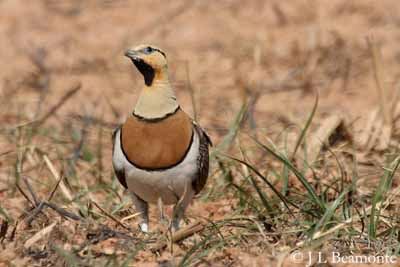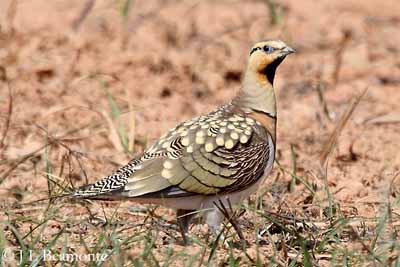
PROTECTION / THREATS / STATUS:
Pin-tailed Sandgrouse is common or locally common in several parts of the range, but the species is threatened in most parts of Europe, due to changes in agricultural practices. It is still common in Spain, and at this moment, this species is not globally threatened.
Fr: Ganga cata
All : Spießflughuhn
Esp: Ganga Ibérica
Ital: Grandule comune
Nd: Witbuikzandhoen
Russe: Белобрюхий рябок
Sd: Vitbukig flyghöna
Port: Cortiçol-de-barriga-branca
Photographs by José Luís Beamonte
Pájaros de España
Text by Nicole Bouglouan
Sources:
HANDBOOK OF THE BIRDS OF THE WORLD vol 4 by Josep del Hoyo-Andrew Elliott-Jordi Sargatal - Lynx Edicions - ISBN: 8487334229
BirdLife International (BirdLife International)
Pájaros de España (JL Beamonte)
Wikipedia (Wikipedia, The Free Encyclopedia)
Pin-tailed Sandgrouse
Pterocles alchata
Pterocliformes Order – Pteroclidae Family
BIOMETRICS:
Length: 31-39 cm
Wingspan: 54-65 cm
Weight: M : 250-400 g – F : 210-370 g
DESCRIPTION:
Sandgrouses are Old World’s species. These birds frequent arid areas and are very well adapted to this type of habitat, thanks to the dense feathering, including tarsi, providing them good insulation against the warm soil.
Pin-tailed Sangrouse adult male in breeding plumage has yellowish upperparts with cryptic pattern and yellow spots. Rump and uppertail coverts are black, finely vermiculated creamy-white. The upperwing shows dark grey flight feathers. Wings are long and pointed. The tail has long central rectrices, giving the bird its English name.
On the underparts, underwing and belly are white. We can see a broad chestnut breast band, bordered with black lines.

The head is pale greenish-yellow on crown, nape and neck. Face and throat are pale chestnut-orange, with black bib from bill to lower throat, and black line from eye to ear-coverts. The latter extends down to the head sides.
The strong bill is greyish. Eyes are dark brown with grey-blue eye-ring. Robust legs and strong feet are grey. The short tarsi are feathered.
Adult male in autumn is paler and duller, with white throat. The black eye-line is thinner or absent. Upperparts lack the yellow spots.
Adult female is slightly duller than male in breeding plumage, and shows two black lines on neck. She has white throat. On the head, crown, nape and rear neck are black. She is smaller than male and has shorter tail.
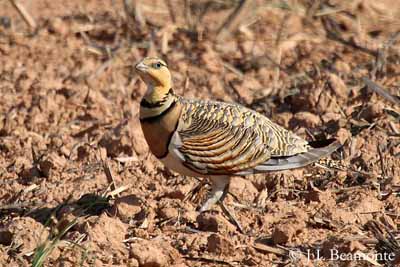
Juvenile is paler with more uniform plumage. It has brown breast and lacks the upper black line.
We find another race, Pterocles alchata caudacutus. It is paler and has longer wings.
VOICE: SOUNDS BY XENO-CANTO
Pin-tailed Sandgrouse gives contact calls in flight. These loud calls are repeated at shot intervals “khattar-khattar”. The French name comes from this sound (cata).
On the ground, the bird utters some clucking sounds.
HABITAT:
Pin-tailed Sandgrouse frequents arid and semi-arid treeless plains such as semi-desert, steppes, dry mudflats near marshes, and dry cereal fields.
This bird avoids dense scrub or tall vegetation, and prefers clay or sandy surfaces. It can be seen in hilly areas and at high elevation.
RANGE:
Pin-tailed Sandgrouse of race “alchata” is sedentary and nomadic in Spain and SE France.
The race “caudacutus” is found in NW Africa, SE Turkey and Middle East. It is resident in North Africa and Middle East, whereas the populations of the northernmost parts of the range are migratory, wintering in Pakistan and NW India.
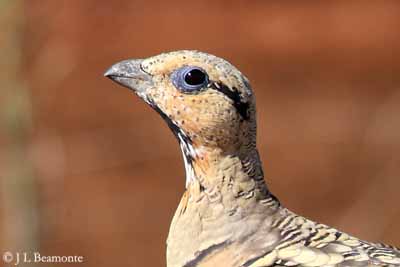
BEHAVIOUR:
Pin-tailed Sandgrouse feeds on the ground, taking mainly seeds, and in less extent shoots and leaves. Its preferred plants are Leguminosae. When foraging in cultivated fields, it feeds on cereal grains and legumes.
This bird drinks during the morning, and needs to drink regularly every day because its diet is particularly dry.
It walks and runs easily and fast, thanks to the robust legs and the strong, short feet, with three front-toes and a small rudimentary raised hind-toe.
Pin-tailed Sandgrouses are gregarious birds and live in flocks of different sizes. In Spain, they are often seen with groups of Little Bustards (Tetrax tetrax).
Sandgrouses are very difficult to see, due to their cryptic plumage and their unobtrusiveness, except when they are flying.
Pin-tailed Sandgrouse are monogamous and breed in isolated pairs or in loose colonies with nests about six metres apart on the ground.
Courtship displays by male are simple. It holds the head low, with wings slightly away from the body, and the tail fanned out and raised.
Before mating, the male approaches its mate holding the legs very stiff and straight and the body erect.
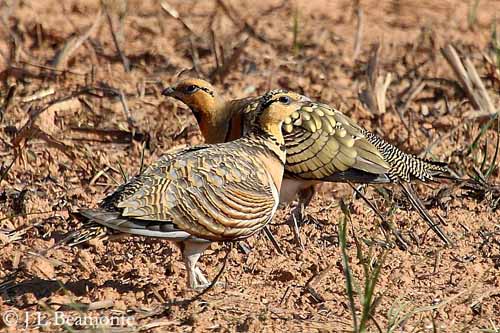
They may also perform aerial displays which are spectacular, at regular times of the day, in the morning and the late evening. These displays are performed throughout the year.
The flock flies in circles at considerable height and speed during several minutes. Small groups or pairs begin to form while calling loudly, and they wheel around interweaving and then, join up again into larger flocks. Sometimes, two or three birds perform fast dive head first in close formation.
These types of displays probably confirm the monogamy and the loosely colonial character of the species.
FLIGHT:
Pin-tailed Sandgrouse has long, pointed wings and strong musculature, allowing the bird to spring up into the air vertically, and to maintain high speeds over long distances.
The flight is strong, direct and sustained, with cruising speeds of about 60-70 km/hour, kept up over long distances. .
The bird performs continuous wing-flapping, only gliding when about to land. Take off is sudden, and when flying in flocks, they fly in close formation, maintaining their distances.
REPRODUCTION:
Breeding season occurs from April to August, with peak in May-June.
Pin-tailed Sandgrouse nests on the ground, in shallow depression or scrape, without lining.
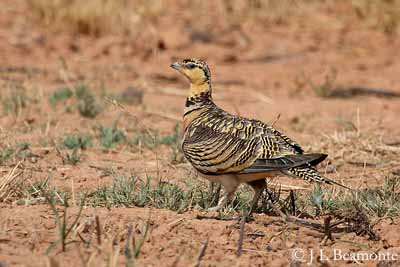
Female lays 3 eggs. Incubation lasts about three weeks, shared by both parents, but mainly by female.
Chicks have cryptic down, ochraceous-brown mottled black. They can fly about 25 days after hatching. They depend on parents for food during 5-6 weeks more.
This species probably produces only one clutch per season, and may lay a second brood is the first is destroyed.
DIET:
Pin-tailed Sandgrouse feeds on seeds, green shoots and leaves, mainly from Leguminosae, but also from other plant species. They can add cereal grains and cultivated legumes.
